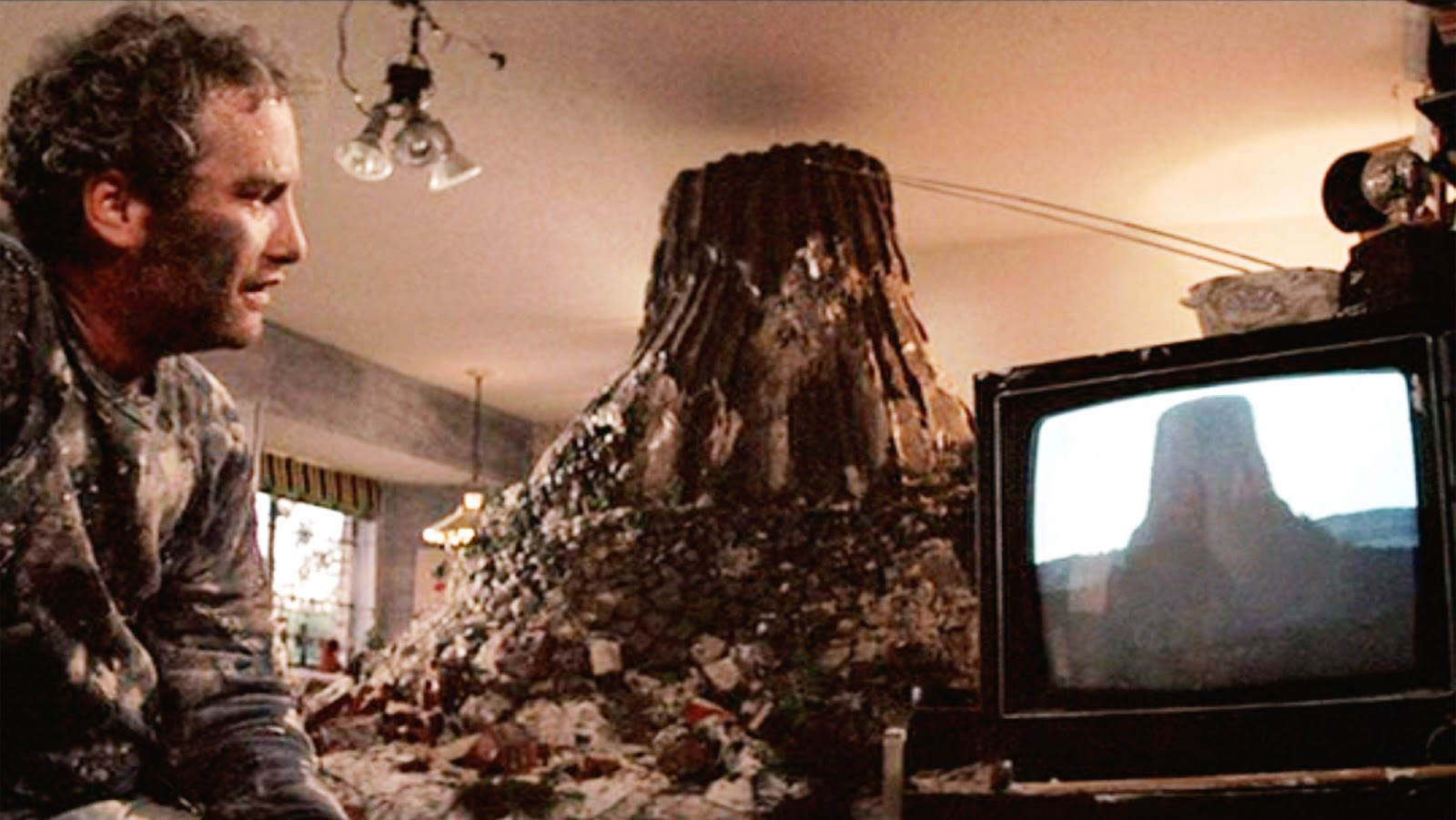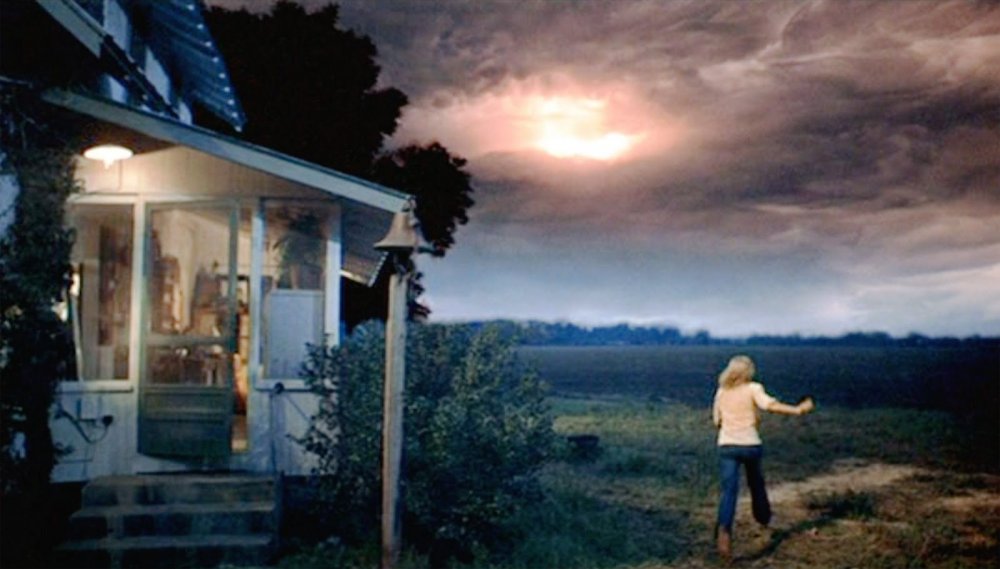Sorry for this review being a day late. Unfortunately, things were stacking up, but I hope you enjoy it anyhow. Who knows, Tuesday could be the best day for a post…
In a close encounter of the first kind, a UFO is seen, but no interaction with the environment is observed. In the second kind, physical effects are observed, like vegetation being pressed down or tree branches being broken. In the third kind, the presence of “occupants” in or about the UFO is reported.
I guess the same could be said about a film. In the first kind, we see, but don’t really have an emotional connection. In the second, mental effects are observed, perhaps like crying, or laughing, or going into a swearing fit. And in the third, we see deeper than just the film, what’s inside it, what it’s trying to tell us.
What kind of confrontation did I have with Close Encounters of the Third Kind? Now that would be telling, wouldn’t it?
The film is about an electricity distribution worker (Richard Dreyfuss) who sights a UFO, along with others all over the country. But the government denies their existence and the peculiar disappearances of certain people, including a child named Barry (Cary Guffey). However, Roy, obsessed with a certain shape, leads his investigation in the Wyoming wilderness, where everyone has been evacuated.

Of course, Close Encounters was made in the 1970’s, when there was no internet, which unfortunately meant there were no movie review blogs! How did they survive? But apart from that, there was no way of spreading the word – who knew a new film was coming out? And that’s what made the poster so vital.
A poster could make or break a film. Someone didn’t like it, they weren’t going. But that wasn’t the case for Steven Spielberg’s feature, with the light at the end of the road. The audience was enamoured and sent flocking. This was a time of superstition, paranoia and curiosity. People wanted to know what was beyond our atmosphere, and they were convinced this film would give them the answer before even going.
It’s something we also saw Spielberg utilise so well with Jaws.

For a 70s film, the special effects are superb. They do look outdated nowadays, but the ship, the aliens, when Barry is being abducted, is all well ahead of their time. If you still can’t bear it, on the 40th anniversary of the film, a digitally remastered version came out, using new technology to try and make the new film more realistic.

What I really like about Roy Neary is he isn’t an exceptional person – not your Al Gore, Hawking and Gygax, but rather your Tom, Dick and Harry. When half his face is burnt from the ship, one of his sons joyously announces that he looks like a 50/50 bar.

He becomes obsessed with this UFO that he witnesses, and it pulls his life apart. He can’t quite explain what he has seen, but devotes hours and hours to it. I think it is very well done, how even though we’ve seen him see the ship, and experience the supernatural event, we still have an inkling he’s going mad. When he’s collecting all the chicken wire, dirt and bushes to build his sculpture, and his wife, Ronnie (Teri Garr), finally snaps and leaves, it’s like he’s finally lost the plot and unbearable to live with. Perhaps it was going to be like A Beautiful Mind, where, like John Nash, we are convinced they are Russian spies till we see it from another perspective. This is probably my favourite time of the film.
But then, he sees the TV.

And then there is no doubting this man.
The cinematography is brilliant, another fine score by John Williams, the casting is excellent and the directing is also exceptional by Steven Spielberg. This is what would make me give the film above an eight.
Sometimes, plot is not important – the film is trying to do or tell you something different, it’s more about the emotions it’s trying to invoke. I feel that is definitely what Close Encounters is trying to do rather than actually tell a story. It’s about the childlike wonder of another form of life, that although that is literally portrayed in E.T. it is better shown in Close Encounters.
However, without a tight, strong plot, the pacing of the film is slow. But, I can’t stress this point enough, that is not what the film is about. The most exciting bit is defiantly when Barry is abducted, with the famous opening of the door and discolouration of the sky.

It will leave you interested, but not thrilled. This isn’t a scary film, and it isn’t designed to be. It’s about amazement, wonder, curiosity and peace, which is very interestingly represented throughout the film as fear, paranoia, mental instability and government control. It seems like the aliens were trying to teach us by abducting people. Of course.
In the 50’s, it had been reds under the bed, where no one could be trusted and the communists were trying to take over the world. In the 60’s, it was the hippies, economic decline and revolutions. In the 70’s, it was other-worldly creatures trying to take over the world, and slaughter mankind. There was also the realisation that even the President of the United States of America could be a lying criminal who didn’t even realise he was being recorded. Close Encounters feels like a culmination of all of them, showing that although this country was an extremely messed up place, it could be fixed. Your opinion on whether it has. Ahem.
If we can talk to aliens in Close Encounters of the Third Kind, why not with the Reds in the Cold War?
Steven Spielberg
As a child, Spielberg had often craved a best friend. But not your usual best friend, but one from another planet. Another world, where you are brought together by your differences. This is pretty much the story of E.T., but we see it replicated subtly throughout most of his films: Super 8, Ready Player One, Bridge of Spies, and Close Encounters of the Third Kind. And the hardest part is having to let go because they are aliens.
This is a classic that has inspired so many alien/extraterrestrial films to this day. And, of course, I couldn’t write this review without mentioning the ending. It’s a happy one, where everyone gets what they want. Apart from Roy.

“Hold the phone, what the hell are you talking about,” I’m sure I hear you saying, but unfortunately, this is the sad truth. If you don’t already know, he gets on the ship and flies off. For me, it’s quite bizarre. But this is not a happy ending for him. He is driven to madness by this episode, and I think it’s exceptional he was even allowed on a crew of some sorts to greet the aliens. His family is destroyed, with his wife and children leaving him. He doesn’t seem remotely upset that he will never see any of them again, which clearly shows me a man who’s unwell. But perhaps this harks back to Spielberg’s wish for a friend. That now Roy will have someone who loves him and he can travel across galaxies fascinated. And he’ll never have to leave them.
So, what type of encounter did I have with Spielberg’s film. I think I’m going to have to go with the third.
Best character: I do like David Laughlin, the French interpreter played by Bob Balaban (great name). I spent the whole film wondering where I had seen this man before, apart from of course being a famous actor, and I was delighted to find that he plays Russell Dalrymple in Seinfeld, who is the man who runs NBC. This didn’t influence my decision at all.

Least favourite character: Urr, maybe Ronnie? Especially when she says, “I’m not getting a job” as son as Roy is sacked, which is very supportive. She’s great in the film, but maybe doesn’t treat him right, although I definitely would have left.
Best scene: As I’ve already highlighted above, Barry’s abduction scene. Brilliant and iconic.

Favourite quote: A humble farmer: “I saw Bigfoot once… made a sound I would not want to hear twice.” And then Roy’s brilliant disgusted look.
Close Encounters of the Third Kind – 7.5 out of 10

Close Encounters Of The Third Kind, like the first contact implications of 2001: A Space Odyssey, can be better viewed as science eventuality, rather than science fiction. We can, in a sense, make up the plot for ourselves as we go along. That’s how I could learn to experience and enjoy both films when I was a kid. Thanks for your review.
LikeLiked by 1 person